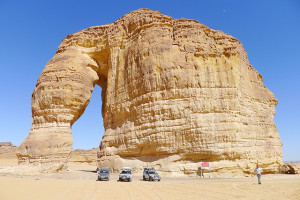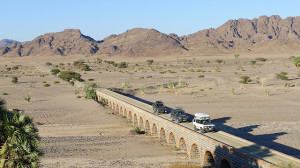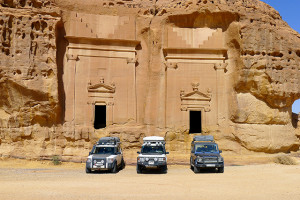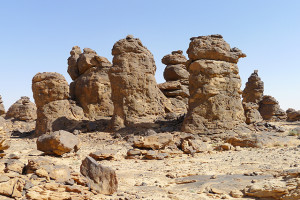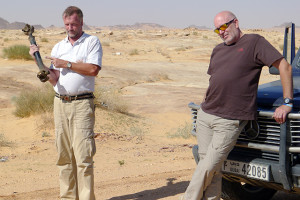Words By: Mike Nott
Photos By: David Chambers, Manuel Schmidt, Kim Merritt and Mike Nott
I’m in danger of using too many of the same superlatives in Part 3 but you’ll just have to forgive me. The track bed was still covered in the original ballast and the indentations from the sleepers and the rails looked remarkably fresh, as if they’d been lifted only yesterday.
It was impossible to drive on, so we had to drive alongside in the soft sand, which presented its own challenges and we stopped to deflate. The group indulged me and I was allowed to lead along the track bed and was thoroughly enjoying myself as it traversed the desert. Perhaps at this point it would be pertinent to explain the railway.
The Hejaz Railway was built between 1900 and 1908 by the Ottomans, ostensibly as a means of transporting pilgrims onwards from Damscus to Medina and the intention was to carry on to Makkah, but this extension was never built. However, the less publically declared reason was that it was a strategic military line into the heart of this part of Arabia and was much used for transporting troops and the equipment of war. Small forts and/or large barracks were built every 20km and three major stations in Saudi at Tabuk, Madain Saleh and Medina. The line became an obvious target during the First World War and the Arab Revolt, aided by TE Lawrence, and was blown up and destroyed in parts. After the war, the part of the line in Saudi was abandoned though parts are still in use in Jordan and Syria.
Our first stop was at a really well preserved line-side small station and water tower. Unusually, as we were to later find, it was not fenced in, so we explored and photographed at will. We then needed to find a campsite and tucked ourselves away in some rock escarpments and walked up to an ancient hilltop fort we’d spotted. It was here that Streaky’s ability to be a human metal detector was outed. He picked up a couple of old Arabic rifle shell cases that none of us had spotted. It was cold that night, down to 6°, and we were to spend the following mornings waking on the railway line dressed in coats and hats and huddling round the fire. As the line neared Tabuk it merged with the roads and we transited Tabuk to try and link up with it on the other side of the town. The line headed directly into a military cantonment and I was getting a little nervous about leading four UAE registered cars with expat drivers into this area but ploughed on anyway. The railway diverted from the cantonment road to where a huge new highway was being built but which had not been opened. Having seen such roads being openly used in the UAE and having come too far to be thwarted, we joined the new road and drove several kilometres along it, knowing the track bed was beneath us or, at times, to one side or another. Eventually we reached the end of the road construction and got back onto the track bed proper.
The line had to cross eastwards through a mountainous area to join a long and wide wadi that led south to Madain Saleh. We knew there was a tunnel along the line and hoped that the road construction hadn’t destroyed it. Almost by accident, we stumbled upon it after a false turn and had a great time driving through it. From here to about 40km outside Madain Saleh we had an incident free drive. We marvelled at the stunning and varied desert landscapes, stopped and visited the abandoned stations, barracks and pristine viaducts, and explored the ancient pilgrimage forts that lay adjacent to the line. We stopped for lunch on a grassy meadow in the shadow of some extraordinary sandstone outcrops, which after further exploration, became more and more remarkable. Tall, isolated pillars of red sandstone that stretched for miles into the distance. As we approached Madain Saleh it became evident that a worrying sound coming from Manuel’s front axle was getting louder and more constant. We stopped, raised a front wheel and rotated it to try to isolate the sound. His differential sounded like a bag of crisps; in fact it was toast. He took off the front prop shaft, we discussed the situation at length and decided, wisely, to slowly cover the short distance to the town of Al Ula, just south of Madain Saleh and work out a plan. As we approached, the landscape became breathtaking. It was reminiscent of Wadi Rum in Jordan; towering sandstone cliffs in a sea of red sand dunes.
Of all the places that Manuel could have “chosen” to break down this was by far the best. Streaky had been here before and after making a short stop at a very rudimentary garage to assess our needs and make a plan, he got to work on the phone to a friend in Riyadh and to the scrap yard owner we had called on in Al Hair. We then headed to the old town, visited the renovated hill top fort, and viewed the partially renovated and incredibly tight-knit mud house old town. Here we were intercepted by another policeman, this time off duty. It became clear he was on our side and discouraged us from camping (some Italian tourists had not fared so well in this area several years before) and suggested we stayed in a local hotel. We booked in and made plans to visit the World Heritage site that is Madain Saleh the next day. Meanwhile Streaky’s friend was planning to go to the scrap yard the next morning and collect a front differential that the scrap yard owner would extract from one of the old Discoveries, which, after some judicial research and confirmatory phone calls, we believed would fit. This was then to be couriered to us at the hotel, hopefully by the next night. In the end, the differential arrived the day after, but more of that later.
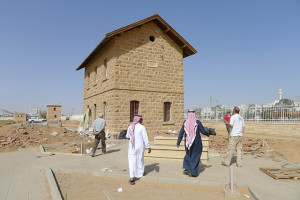
Most people are aware of Petra, the ancient Nabataean capital in Jordan, and the incredible tombs and civic buildings they carved out of the solid sandstone mountains. Well, Madain Saleh is the Nabataean’s southern most city and they had, similarly, carved out tombs and civic buildings from the local sandstone mountains. It is also, as an added bonus, the best preserved railway station and museum on the railway, hence its World Heritage status. We had the unique privilege of touring the entire area unescorted and unmolested. We spent the whole day here, clambering in, on and over the tombs and sandstone hills and visiting the exceptional museum. At the end of an extraordinary, and unlikely to ever be repeated, day we returned to the hotel to find that the differential would soon be on its way but would arrive by about 2pm the following afternoon. We thus had a second spare day to fill and there was more to see in the area (you see what I mean about Manuel’s “choice”). The next day we spent visiting the excellent local museum, the Lions Tomb area, which had been carved out of the sandstone cliffs by a civilisation pre-dating the Nabataeans, going to Al Ula railway station and its oddly, old, abandoned railway wagons on the side of a residential road, and finally went to Elephant Rock for a late lunch picnic in the shadow of this most picturesque place. All the time we were waiting for the phone call from the hotel to tell us the diff had arrived.
Eventually by 6pm we had the diff in our hands and needed to fit it somewhere. We found a friendly garage, in a petrol station forecourt, who lent us two axle stands and we set to work. This was obviously an odd sight and we were bombarded with questions and greetings by the local youths and the numerous pre-teen children who were doing their best to burn rubber at the nearby roundabout in cars, which must have been fitted with booster seats and blocks on the pedals. We worked well as a team and after four hours we had fitted the new diff, re-fitted the prop shaft and were good to go (Note, if any garage tells you that this is a two-day, or even one-day job, you’re being diddled!). While we worked, a local shop owner had brought us Arabic coffee and sweets and even donated some gifts; the local people were exceptionally friendly. It now being after 10pm, it was too late to leave so we headed out the next morning but Kim had run out of time and so headed home from here, straight to Abu Dhabi, in one go, 2000km! Streaky, Manuel and I headed southwards to rejoin the railway. As a guestimate, we’d probably lost two days from the trip and realised that we were not going to get to the Yemen border with what time we had left.
South of Al Ula the railway is paralleled by and also built over by a new road for about 40km but then bears off to the right and into the deeper desert. All along the line there are deposits of railway ballast that were placed for maintaining the line. These piles of ballast are perfectly flat and square sided and we could only blame the German engineers for insisting on such precision for rock piles. Why they hadn’t been used since for road construction was a bit of a puzzle.
As we moved on we had another ancient pilgrimage fort to visit about 1.5km from the line and turned off towards it. It was in pretty good condition but fenced. As we stopped to take photos we were joined by a goat herder from out of nowhere who insisted that we could not take photos of this oft-photographed fort and he started to take photos of us, so we took photos of him. The next stop was a major one for me. It was the railway sidings at Al Hadiya. We arrived at dusk to find it well fenced and the two trains, one of which was lying on its side, and the station were well protected. I felt a sense of disappointment but it was now dusk and we had to find somewhere to camp. Have I mentioned the landscape? It was a classic desert-scape mixture of black rock mountains and red sand dunes, and was stunning. We camped in amongst some firm dunes. We had something of a mechanical scare in the morning. Manuel’s fuel filter was leaking diesel and the car wouldn’t start. After a couple of satellite phone calls to some diesel engine gurus, a careful reading of the handbook and some ad-hoc engineering, we got the car going and it never failed again. We headed back to the siding yard and discovered a human-sized hole in the fence. As has been said elsewhere, I can resist everything except temptation. Manuel stood close and I squeezed in to take the photos that were to be the epitome of the trip for me. Streaky joined us, having been photographing old sleepers used as fence-posts, and squeezed in too. This had now overcome my disappointment at finding one of the famous line-side locomotives earlier in the trip having being cut to shreds by opportunistic scrap metal hunters.
There was not much of the railway left as we were nearing Medina but the desert-scape continued to be increasingly impressive; bigger sharper mountains, semi-covered by huge yellow dunes. It’s a staggering area of natural beauty and we wished that we could have spent more time there to explore all its corners. We finally reached the road into Medina, turned off to camp for the night and celebrated the completion of the Hejaz Railway with some sparkling grape juice (seriously). We now had to get home and staged ourselves through Riyadh, staying with Streaky’s friends who’d made the trip possible by couriering the diff to us in Madain Saleh and who were very generous with their home-brew. A quick tour of the sights of Riyadh, one final, chilly night in the dunes south of Al Hotuf, a photo call on the beach opposite the Qatar peninsula, a frankly surprisingly rapid transit through Saudi and UAE immigration and customs, and we were on the final stretch and eventually home.
Clichés notwithstanding, this had truly been the trip of my lifetime; the freedom to explore, the length of stay, the sights and landscapes were remarkable but it is unlikely that I’ll be able to repeat it, and this is the tragedy of Saudi. There is so much to see, so much ancient history, so much diverse and natural beauty but it remains so difficult, if not impossible, to be a free roaming tourist and traveller. Streaky, I owe you a non non-alcoholic malt drink!

